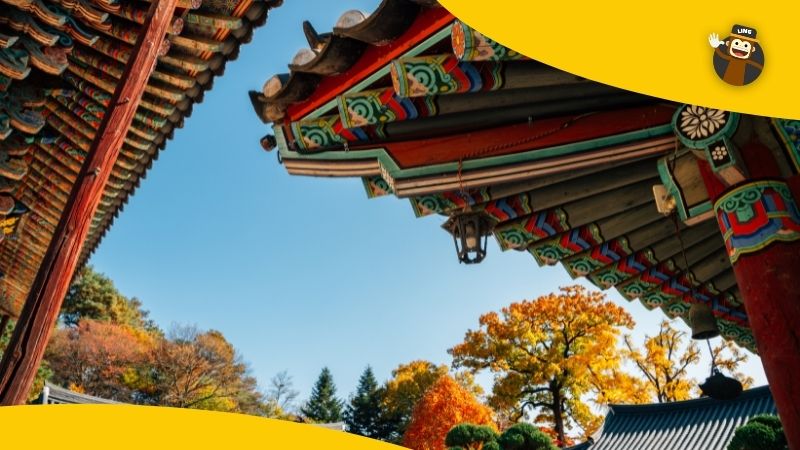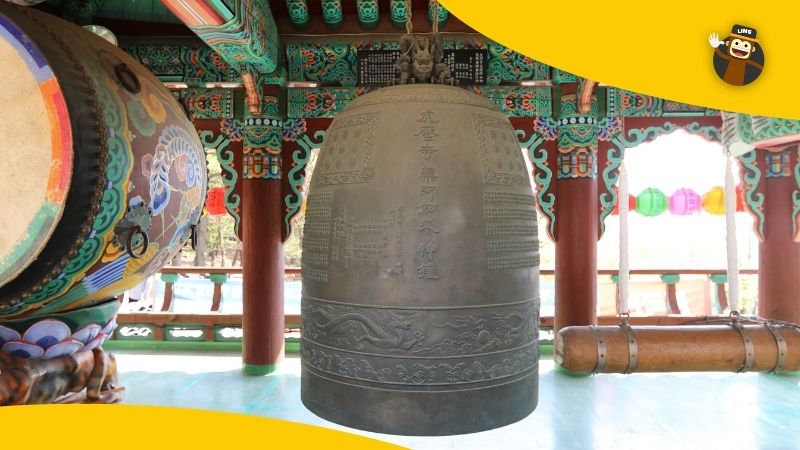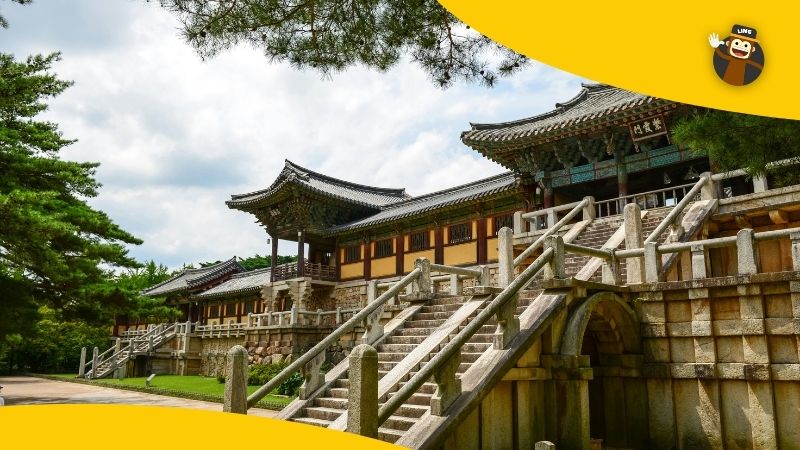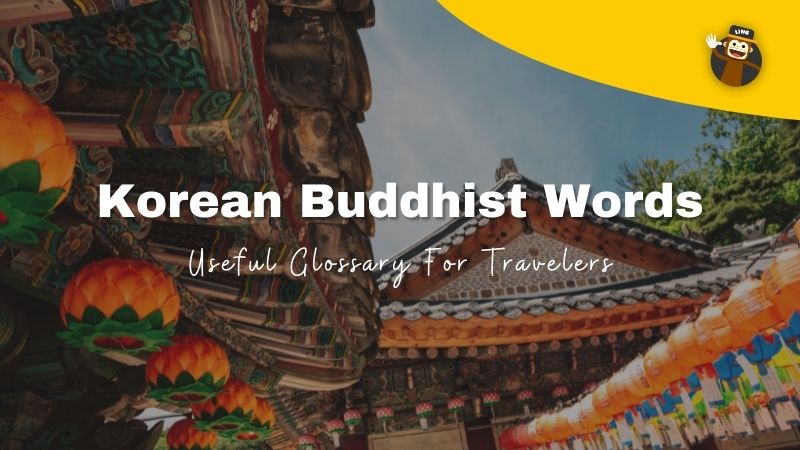If you plan your long dreamed trip to South Korea and love Korean Buddhism, visiting the most famous temples and, better yet, experiencing a temple stay is the best way to create fulfilling memories. Be well prepared for that life-changing experience by previously learning Korean Buddhist words to communicate appropriately and gain more insight into Korean culture and religion.
While traveling around South Korea, you will visit famous tourist attractions, many of which will be temples, monasteries, and Buddhist museums. If you learn more about those places, including Buddhist terminology, your experience will be more significant. Whether you visit a temple or decide to stay longer, you will be able to engage in rewarding conversations with the monks and apprentices and have the opportunity to show them how knowledgeable you are about Buddhist studies, Korean religion, and terminology.
Staying at a temple in Korea is a period of spiritual development. You can see the simple yet meaningful life of Buddhist monastics. You can engage with Buddhist traditions learn about mindfulness, dharma teachings, and general East Asian Buddhism. It is also the perfect opportunity to start your meditative cultivation and improve your mental health.
Imagine that you are staying for a couple of days in Donghwasa (동화사), in the north of Daegu city. A beautiful sacred place up in the mountains, in the middle of a forest and streams. You wake up at 4 am feeling refreshed and get ready for a meditation practice with a Monk in a Buddha hall.
Then you will have a delicious and healthy vegan breakfast. You will go hiking around the mountains with a Monk telling you about ethical commitments, dharma, and compassion. You will have the opportunity to make your beads/rosary (단주 – danju) and have it blessed by the Monk. After a meditative practice, you will feel refreshed.
Imagine helping the monks with errands and experiencing how daily monastic life is. Enjoying stories during tea ceremonies will make you feel like you are in another century, while the meditation retreat will help you relieve suffering and practice mindfulness.
Sounds incredible, right?
If a longer visit is not for you, visiting a Korean temple for at least a couple of hours is also a must and will fulfill your expectations. So, at the end of this post, I’ll leave my top 6 Korean temples you should visit while in South Korea.
Read on and be prepared for the inspiring journey that may change how you see life.

Comprehensive List Of Buddhist Words For Your Korean Adventure
Common Words Related To Korean Buddhism That You Should Know
Out of the Buddhist vocabulary from the list, words like ‘바라밀’ (balamil), which its literal translation is Paramita, 보살 (bosal), meaning Bodhisattva, and 수인 (su-in) meaning Mudra, are Buddhist terms that people don’t use in their daily lives. However, if your Korean level is intermediate or higher, you might have caught some words that you can use in a typical conversation, such as 하심 (hasim), which, as you saw on the table, means ‘humble.’
Other Fascinating Buddhist Terms
What Is The Korean Buddhist Word For Calm/Tranquility?
In Buddhism, the Sanskrit word ‘samatha’ means ‘stop to end’ and refers to calmness and tranquility. In the Korean language, the word comes from the Han character ‘止’, which in hangul is ‘지’ (Ji).
This term expresses the meditation practice used to calm the mind and achieve a’ trance’ state, far from bad thoughts, negativity, and desire.
What Is The Korean Term For Entering The Monastic Life?
When a person becomes ordained as a Buddhist Monk or Nun, they have to shave their head and wear Buddhist robes. In the Korean language, this is called 득도 (Deukdo), which could be translated to English as ‘entering the monastic life.’
What Is the Term For ‘Noble Eightfold Path’?
East Asian and Korean Buddhist thought says that the noble eightfold path refers to the eight practices that a person must follow to cease all suffering and achieve nirvana. It is the manual that people have to attain enlightenment. The Korean term is ‘팔정도’ (paljeongdo), which translates to ‘eightfold.’
On the contrary, 팔사행 (palsahaeng) refers to the eight evil paths. Those will hold you back from achieving enlightenment or the Buddha realm.

Do you still want to learn more? If this gives you as much passion as it does to me, you will quickly remember this vocabulary to use while you visit a Temple in Korea.
Let’s dive into some words and phrases related to Korean Buddhist temples!
Common Korean Words Related To Korean Temples
After learning these Korean Buddhist words, you will be able to respectfully call the monk 스님 (sunim) while you are at the 다도 (dado-tea ceremony) during your temple stay. Also, you will visit the Buddha Hall or 법당 (beobdang) to see the altar of offerings, 불단 (buldan), and you will be able to name the locations and objects that you see around.
Notice how every word that refers to Buddha has ‘불 (bul)’ in it. Remember that this term is one of the ways to refer to the Buddha.
The 6 Most Beautiful Buddhist Temples In South Korea
Now that you are ready with enough Buddhist vocabulary, it’s time to plan which temples you should visit. There are many tourist attractions in South Korea, but the temples have the power of transporting you to ancient times of monastic life. It is even magical.
So, I have prepared a list of my favorite Buddhist temples that I believe every tourist should visit at least once.
Try to learn how to pronounce these names. You never know if you will have to ask for directions from a local! Yes, it is always a good idea to be a step ahead and learn as much of the vocabulary as possible, especially when it comes to important names such as a Buddhist Temple.
Besides, it will make you feel good if, as a tourist, you travel with enough information about the place. Having at least a bit of insight before your trip shows how much respect you have for the location.
My 6 Favorite Temples
Try visiting at least one of these temples during Lotus Lantern Festival to celebrate Buddha’s Birthday. You will notice how Korea and its temples become even more beautiful and colorful because of the lantern designs that decorate the streets and monasteries.
- Bulguksa (불국사): My all-time favorite place in Korea! Such beauty in the old capital of the Silla Dynasty, the impressive city of Gyeongju. It is also a UNESCO World Heritage Site. I suggest you visit Bulguksa during 가을 (Gaul)—autumn for the most breathtaking scenery.

- Donghwasa (동화사): Situated in the north of Daegu. In this temple, I had the most incredible, enriching, peaceful, and memorable four days I’ve had during my four years in Korea. I learned about Korean Buddhism, Buddha teachings, the Sangha, compassion, and meditation practices that elevate inner qualities during the temple stay program.
- Beopjusa (법주사): An impressive temple of the Silla period, close to Cheongju, and dedicated to the Buddha of the Future. Beopjusa has a beautiful five-story wooden Pagoda, a 33 meters bronze Buddha statue, and beautiful forest scenery. Another perfect place to experience meditation and least Asian Buddhism.
- Botapsa (보탑사): A divine Buddhist temple surrounded by mountains, beautiful flowers, and a lake. You can climb up the 3-story wooden pagoda to have an even more fantastic view during your visit.
- Haedong Yonggung (해동 용궁사): I have visited this place two times, and I wish I could see even more of it. It’s situated on a cliff along the shore of Busan, making it a unique temple for visitors, as Temples are often hidden up in the mountains. I would never have enough of sitting surrounded by Buddhist halls, Buddha statues, trees, and rocks, while I enjoy the ocean view and the horizon. Make your visit even more meaningful by going to New Year to make a wish at midnight, as Korean Buddhists do.

- Golgulsa (골굴사): Do you want to see flying monks? In this beautiful grotto temple of the Silla Dynasty, you can allow yourself to learn the traditions of the Seon (Zen) Korean Buddhism by practicing Sunmudo (선무도). Sunmudo is a traditional Buddhist martial art that means ‘the way of war of the Seon.’
Learn Korean Language And Culture With Ling App!
I believe that tourists should never get tired of visiting Korean temples; even if you think you’ve seen enough about Korean Buddhism, one unique temple is still waiting for you.
Remember to learn as much as possible about each location before visiting. And enhance your experience by learning Korean Buddhist words. If you practice the vocabulary I just shared with you, you will deeply understand Korean Buddhism. Besides, I promise this will help you make long-lasting connections with the people you meet during your travel. Impress them with your knowledge of Korean religion, language, and culture!

Begin your language learning journey today! Learning Korean with Ling App feels as if you are playing a game. It’s an easy and convenient language learning app that will motivate you until you achieve the level that you have always desired.
Practice from basic to advanced vocabulary with the most engaging and efficient exercises. Be confident speaking to locals while traveling around the country and staying at Buddhist temples.
Start Learning Korean today!











